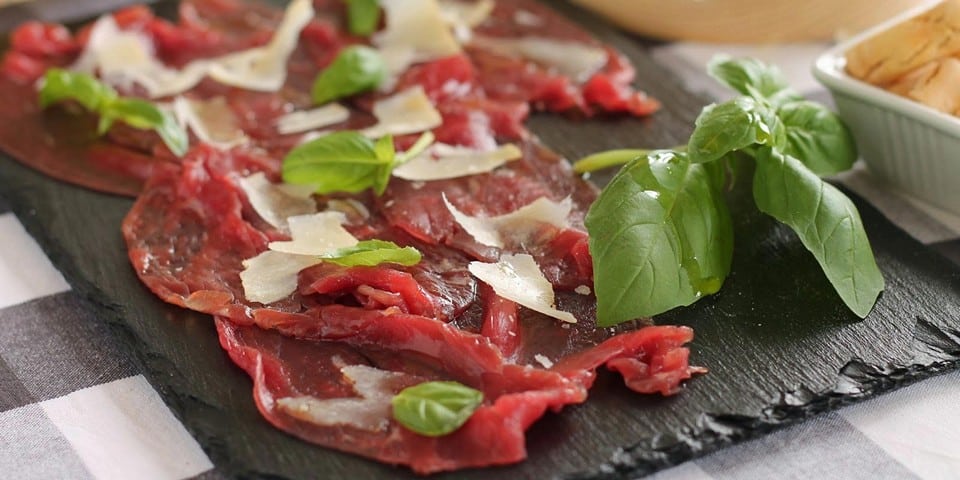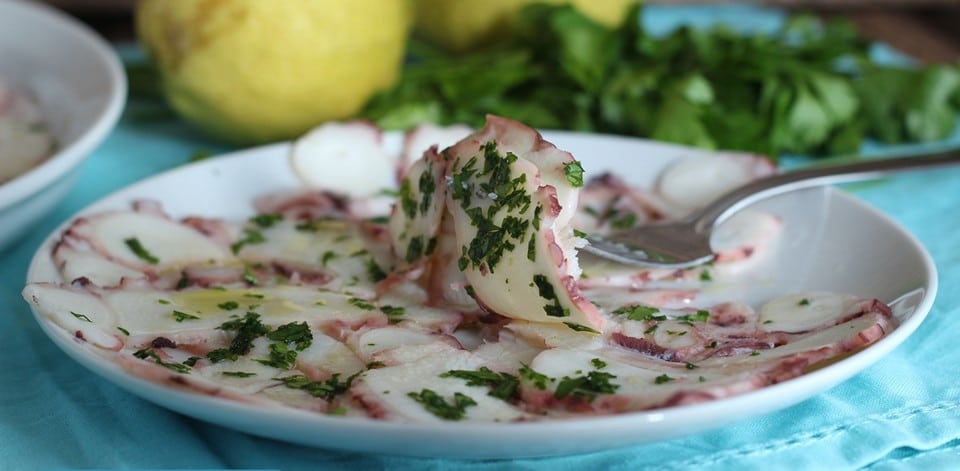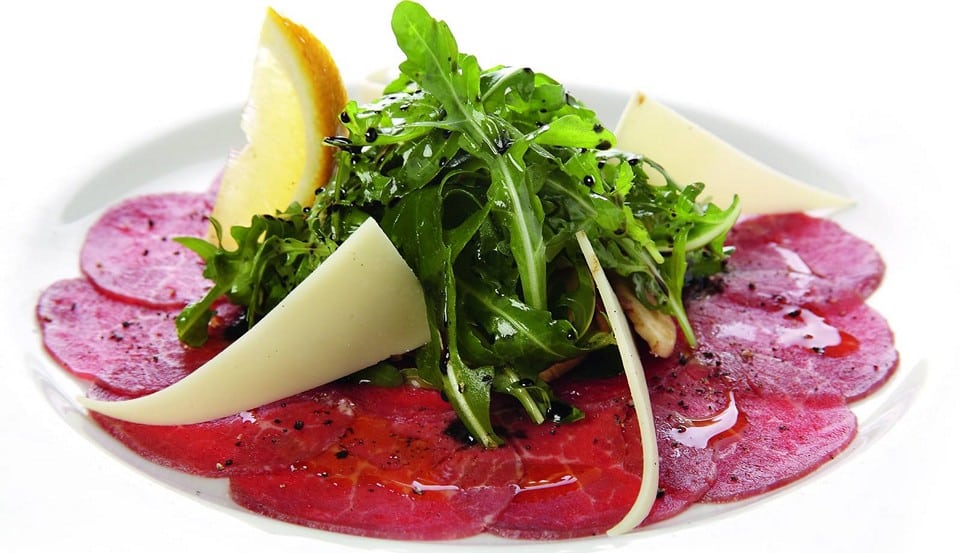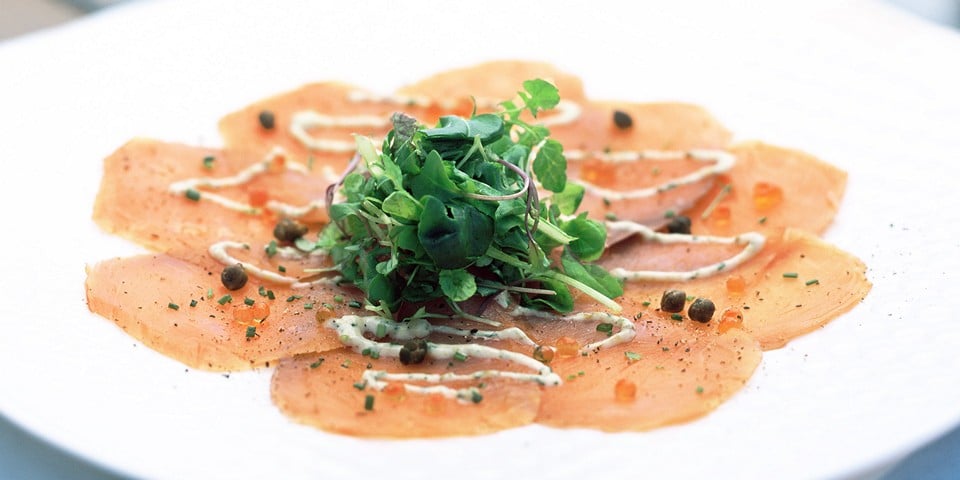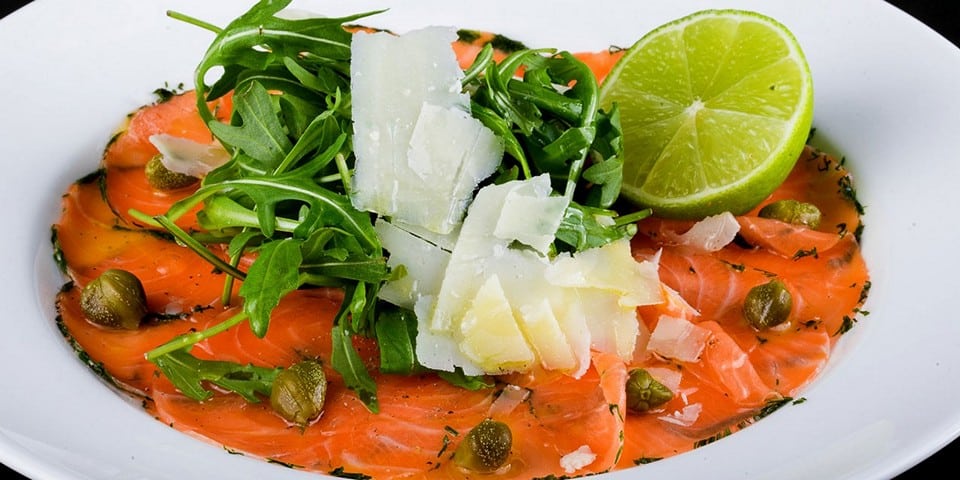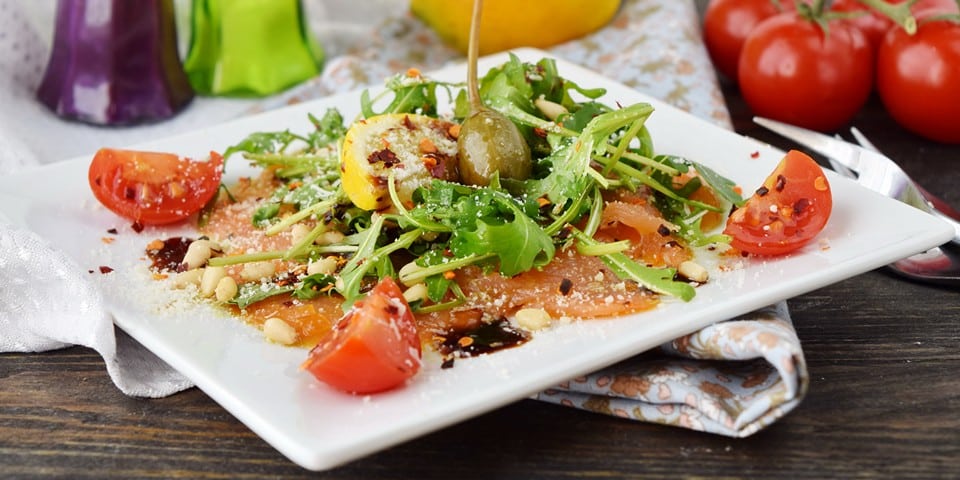Simplicity, originality, and exquisite taste are the three criteria that literally make the hostess stop her choice of a particular dish. Carpaccio, undoubtedly, meets all the requirements. It is a traditional Italian appetizer consisting of thinly sliced raw beef, drizzled with olive oil and lemon juice and garnished with capers and onions.
Page Contents
What is Carpaccio?
Carpaccio is an Italian appetizer that originally consists of very thinly sliced pieces of raw beef, drizzled with olive oil and lemon juice, and garnished with capers and onions.
Historical background
The dish owes its name to its inventor, Giuseppe Cipriani, who one fine day in 1950 sliced raw meat for his friend Amalia Nani Mocenigo. The poor woman was prohibited by doctors from consuming cooked meat, and her devoted companion found a solution to the situation.
The appetizer was named after the painter Vittore Carpaccio. The sight of the raw beef reminded Cipriani of the vibrant colors in the painter’s artworks, as an exhibition of his works was taking place in Venice at that time.
The owner and chef of the Venetian café Harry’s Bar found his innovation well-received by the visitors. Since then, the popularity of Carpaccio has only grown.
Currently, there are numerous variations of the dish. Different types of meat, fish, seafood, as well as vegetables and fruits, serve as the “canvas” for slicing. They are served with corresponding sauces.
As a rule, Carpaccio is accompanied by a bed of greens. The most common options include arugula, radicchio, and watercress.
One of the key components of the classic appetizer is lemon. Its juice is mixed with mayonnaise. This combination beautifully enhances the flavor of the meat.
Parmesan flakes have become synonymous with Carpaccio worldwide. The cheesy notes not only enrich the taste of the meat but also highlight its finest nuances.
The most unusual variation of Carpaccio is Octopus. It is not actually a raw dish. The octopus meat is boiled until cooked and sliced into thin slices. Before serving, it is dressed with vegetable oil, lemon, salt, and herbs.
The most expensive and exquisite version of Carpaccio is the one with white truffle. The thinnest slices of beef are complemented with Parmesan flakes and slivers of mushrooms.
Recipe with beef
Carpaccio made with beef remains a popular classic in the world of appetizers. It is ideal for various serving options. In the summer, it can be enjoyed as a main dish accompanied by bread, while in the winter months, it is used as an antipasto or second course.
So, to prepare Carpaccio, you will need:
- Beef – 0.88 lbs (400 g);
- Hard cheese flakes – 3.5 oz (100 g);
- Arugula – 3.5 oz (100 g);
- Lemon juice – 2.5 fl oz (70 g);
- Olive oil – 3.4 fl oz (100 ml);
- Black pepper and salt to taste.
To create the classic dish, the best cut of beef to use is fillet or tenderloin. The meat should be fresh, not thawed.
With all the ingredients on hand, let’s start preparing. First, we’ll focus on the sauce. Squeeze fresh lemon juice and mix it with olive oil, salt, and pepper. Whisk the mixture until it forms a smooth emulsion.
Evenly spread arugula on the serving dish. Slice the meat using a slicer or a very sharp knife into thin slices, about 0.08 inches (2 mm) thick.
Arrange the beef slices on top of the greens, sprinkle them with hard cheese flakes, and drizzle with the sauce. To allow the meat to absorb the accompanying flavors, refrigerate it for 10 minutes to marinate. Garnish the Italian delicacy with a lemon wedge and serve.
It’s worth noting that in modern Italian cuisine, raw beef is often replaced with cured or smoked variations of the product.
It is recommended to prepare Carpaccio just before serving. The maximum storage time should not exceed 12 hours.
Recipe with Chicken
Contrary to the historical classics, economically advantageous dishes are gaining more and more popularity today. Thus, more expensive beef is being replaced on the table by chicken.
Based on the preferences of homemakers, we present two variations of chicken Carpaccio for your attention.
Using Raw Chicken Breast
True Carpaccio always consists of raw ingredients. To prepare it, you will need:
- Chicken breast – 1.76 lbs (800 g);
- Olive oil – 6 tablespoons;
- Soy sauce – 4 tablespoons;
- Lemon – 2 pieces;
- Green onions, basil, salt, and pepper to taste.
When buying chicken for Carpaccio, it is important to check the veterinary certificate to avoid contamination with pathogens of dangerous diseases.
To begin, wrap the chicken breasts in foil or parchment paper and place them in the freezer for one hour. This surface freezing of the meat will facilitate easy slicing. Remove the fillets from the refrigerator and cut them into thin slices about 0.08 inches (2 mm) thick.
Mix freshly squeezed lemon juice with olive oil, salt, coarsely ground pepper, green onions, and basil. Add soy sauce and whisk the mixture with a whisk until it becomes an emulsion.
Pour the sauce over the chicken breast arranged in a dish and return everything to the freezer for 30 minutes.
15 minutes before serving, remove the dish from the refrigerator. Garnish it with fresh basil leaves and lemon wedges. The tangy taste of citrus and the delicacy of the chicken meat create a unique sensation of tenderness.
Recipe with Boiled Chicken Breast
Not every gourmet is willing to try raw meat due to the presence of numerous infections today. But there are recipes for Carpaccio made from cooked ingredients for such cases.
Our “cautious” Carpaccio is an example of a middle ground in preparing this famous delicacy. For this recipe, you will need:
- Chicken breast – 1.32 lbs (600 g);
- Carrots – 2 pieces;
- Honey – 1 tablespoon;
- Cloves – 2 pieces;
- Celery – 2 pieces;
- Thyme – 1 bunch;
- White wine – 20 fl oz (600 ml);
- Apple cider vinegar – 2 fl oz (60 ml);
- Olive oil – 2 fl oz (60 ml);
- Onion – 1 piece;
- Ginger root – 1.76 oz (50 g);
- Dill seeds – a pinch;
- Salt and black peppercorns to taste.
Boil the chicken breast. To do this, pour 8 cups (2 liters) of cold water into a pot and add 1 piece of celery, 1 large carrot cut into half-rings, half of the onion sliced, 2 cloves, a bunch of thyme (tie it with kitchen twine, leaving a couple of sprigs for the sauce), 7 fl oz (200 ml) of white wine, and a few peppercorns. Bring everything to a boil, add salt, and immerse the chicken breast in the brine. Cook for an additional 7-8 minutes, then turn off the heat and let the meat cool in the broth.
Finely chop the remaining carrot, celery, thyme sprigs, and onion. Slightly sauté them in a non-stick skillet without adding oil. In a separate saucepan, combine 14 fl oz (400 ml) of wine, apple cider vinegar, honey, peeled and thinly sliced ginger root, dill seeds, cloves, and 5-6 black peppercorns. Simmer over medium heat until approximately 1/4 of the liquid evaporates. Then turn off the heat, add salt, strain the sauce through a sieve, and let it cool.
Once the sauce reaches room temperature, add olive oil and whisk everything together. Slice the cooked chicken breast into thin slices (0.08-0.12 inches or 2-3 mm thick), arrange them on a dish, pour the marinade over the slices, and optionally garnish with julienned carrots.
Recipe For Salmon Carpaccio
Salmon Carpaccio is a wonderful alternative to meat-based slices. It’s an excellent idea for a quick and healthy dish for your festive table. The combination of the amazing aroma of citrus and the unique tenderness of salmon in a fish appetizer with Citronette sauce is perfect. Here are the ingredients you’ll need:
- Salmon fillet – 10.6 oz (300 g);
- Olive oil – 6 tablespoons;
- Lemon juice – 2 tablespoons;
- Orange juice – 2 tablespoons;
- Honey – 1 tablespoon;
- Salt to taste;
- Basil.
Choosing high-quality fish can be a challenging task. Remember that there should be no blood stains on the salmon’s scales. Fresh salmon has an elastic and firm texture, and its color should be pink or a delicate orange. The eyes of good fish are light with dark pupils, and it has a pleasant aroma of seawater.
In the first step, wash the salmon fillet thoroughly and pat it dry with paper towels. Slice it into thin, skinless slices using a sharp knife. Arrange the fish on a serving dish.
For the Citronette sauce, mix the freshly squeezed orange and lemon juice in a bowl. Dissolve the honey in the mixture and season with salt to taste. Add the olive oil and whisk everything together with a whisk. Finally, add the chopped basil.
Pour the prepared sauce over the salmon fillet and refrigerate for 1 hour to marinate. Before serving, you can drain any excess Citronette sauce.
The Calorie Content and Benefits
Classic beef Carpaccio is a dish whose calorie content is determined by the energy value of the main ingredient, although the amount of added oil also plays a role. On average, the calorie content of beef Carpaccio ranges from 150 to 200 kcal per 100 g, and it consists of the following:
- Protein – 71%;
- Fat – 28%;
- Carbohydrates – 1%.
The fat content in Carpaccio is mainly composed of monounsaturated fatty acids. It also contains a moderate amount of cholesterol (30.6 mg). Therefore, individuals with weight issues or cardiovascular diseases should consult with a doctor before consuming it.
Carpaccio is rich in high-quality proteins, making it an excellent food for athletes during periods of intense training.
Among the mineral salts found in beef, iron and potassium are predominant. Iron contributes to proper blood formation, while potassium helps normalize heart function.
As Carpaccio is not subjected to heat treatment, all the vitamins present in the meat are preserved:
- Niacin (5.58 mg), also known as vitamin PP, regulates oxidative processes in the body and is involved in metabolism.
- Vitamin C (9.15 mg), or ascorbic acid, has powerful antioxidant properties.
- Vitamin E (1.36 mg), or tocopherol, stimulates immunity and participates in hormone synthesis.
It is not recommended for pregnant women to consume traditional Carpaccio, as raw meat can potentially be a source of disease-causing agents (parasites, bacteria, viruses).
The article is complete, which means you now have several incredible recipes for your festive table. Cook with confidence, love openly, travel with an Italian accent, and remember: “Those who do not take risks do not eat Carpaccio!”
Interesting Facts about Carpaccio
- Carpaccio, a famous Italian cold appetizer, was invented in 1950 by Giuseppe Cipriani, the founder of Harry’s Bar in Venice. It was inspired by the painting of Vittore Carpaccio, which featured vibrant red hues similar to the thinly sliced raw beef used in the dish.
- The traditional Carpaccio is made with raw beef, typically tenderloin or sirloin, sliced paper-thin, and marinated in a flavorful dressing. However, variations of Carpaccio can be made with other ingredients such as fish, seafood, or even vegetables.
- The name “Carpaccio” was given to the dish by Giuseppe Cipriani as a homage to the Venetian painter Vittore Carpaccio. The vivid red tones of the meat reminded him of the vibrant colors used in Carpaccio’s artwork.
- The thin slices of raw beef used in Carpaccio are often pounded or flattened to achieve a uniform thickness. This enhances the presentation and helps tenderize the meat, resulting in a melt-in-your-mouth texture.
- Carpaccio is typically served as an appetizer or a starter, accompanied by various garnishes such as arugula, Parmesan cheese shavings, lemon juice, olive oil, and freshly ground black pepper. These elements provide a balance of flavors and textures to complement the delicate beef.
- While Carpaccio is often associated with beef, several creative variations use different proteins. For example, Carpaccio can be made with thinly sliced salmon or tuna, marinated in a citrus-based dressing, and served with capers and fresh herbs.
- Carpaccio has gained international popularity and is now enjoyed in various parts of the world. Chefs and culinary enthusiasts continue to explore innovative versions of Carpaccio, incorporating local ingredients and flavors, making it a versatile and exciting dish in the realm of Italian cuisine.
 Italy for me From Italy with love
Italy for me From Italy with love


